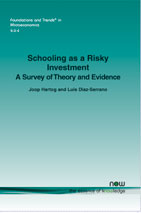Schooling as a Risky Investment: A Survey of Theory and Evidence
By Joop Hartog, Universiteit van Amsterdam, The Netherlands, j.hartog@uva.nl | Luis Diaz-Serrano, CREIP- Universitat Rovira i Virgili, Spain
Abstract
The survey primarily seeks to expose the literature, presumably in a well-organized framework. There is no attempt to present any new analyses; only the chapter that lays out the potential scope for the presence of risk in schooling decisions contains some data specifically collected and organized for this survey. In presenting the models, emphasis is on exposing assumptions and results, and leaving intermediate algebraic manipulations mostly to the original sources. The survey will reveal a rather rugged terrain. It is not so difficult to expose ex post variability in outcomes, but much harder to indicate how much of this variability measures ex ante risk. We have theories and models, but not a commonly applied and generally accepted standard model. Empirical evidence is often conflicting, mostly incomplete and in many cases sparse and singular. Only on a few issues can we draw firm conclusions and consider the case closed. On most issues we can only call for more research. It is, indeed, a challenging field worthy of much more attention than so far has been devoted. We need more theoretical effort to develop a work-horse analytical model and more empirical work to measure the risk that is associated with alternative schooling options and to estimate its effect on schooling choices. In particular the many policy choices on design of school systems (such as curriculum design, tracking, financial support for students) should be based on more robust empirical evidence.
Schooling as a Risky Investment
Schooling as a Risky Investment Schooling as a Risky Investment: A Survey of Theory and Evidence focuses exclusively on the risk that is associated with investing in education. In this monograph, the authors' acknowledge that in educational choice, risk is everywhere, and that the variables affecting this choice are imperfectly known. Only recently has modern economic theory faced these issues. In a well organized framework, this monograph surveys the modest literature, identifies and explains the weakest aspects of knowledge in the field, reflects on policy issues, and presents an agenda for future research.
Schooling as a Risky Investment: A Survey of Theory and Evidence is organized as follows. After an introduction, Section 2 presents data on ex post variation in outcomes, and evidence on student perceptions of variability and risk to show that risk is a relevant dimension for individual decision making. As a background to the models acknowledging uncertainty, Section 3 briefly considers models for investment in human capital under conditions of perfect information and a perfect capital market. Section 4 presents empirical evidence on the effect of risk on schooling choices. Section 5 surveys the literature for empirical evidence on the relationship between level of education and dispersion in earnings. Section 6 considers methods to cope with risk such as hedging human capital risk and self-insurance through consumption smoothing. Compensation in wages for the risk associated with schooling investment is then considered in Section 7, followed by a look at policy issues in Section 8. Finally, in Section 9, the monograph concludes by summarizing what is known and identifies interesting issues and directions for future research.
